As an Amazon Associate CoffeeXplore.com earns from qualifying purchases.
Blue Milk Tea Recipe And Secrets For Perfect Boba
Have you seen that stunning, vibrant blue drink on social media? You’re not alone in wondering how to create that magic at home.
This drink is Blue Milk Tea, a specialty beverage that gets its incredible color from a natural flower, not artificial dyes. The challenge is often achieving that perfect cafe-quality look and taste without a complicated process. You want a recipe that’s both easy and impressive.
Blue Milk Tea is an herbal, caffeine-free beverage made from the infusion of Butterfly Pea Flowers, mixed with milk and a sweetener. This ultimate guide will walk you through the simple steps and expert secrets to craft the perfect Blue Milk Tea with chewy boba, right in your own kitchen.
Are You Ready to Master the Viral Blue Milk Tea Recipe?
That mesmerizing blue hue isn’t from a bottle of food coloring—it’s the work of a beautiful, natural ingredient called the Butterfly Pea Flower. This flower, known scientifically as Clitoria ternatea, is the secret behind the entire aesthetic. When steeped, it releases a potent, deep blue pigment that can even change color with a little kitchen science.
This guide is your definitive source for not only replicating the look but mastering the flavor and texture. We’ve used tested ingredient ratios and professional preparation techniques to ensure your homemade blue milk tea is just as good, if not better, than what you’d find in a specialty boba shop. Forget guesswork; we’re covering everything from sourcing the best flowers to cooking the chewiest boba pearls.
9 Expert Secrets for the Perfect Blue Milk Tea and Chewy Boba
Achieving a cafe-quality blue milk tea at home comes down to a few key details that many recipes overlook. The two biggest challenges are getting that intensely vibrant blue hue without any artificial dye and mastering the perfectly chewy ‘Q’ texture of the boba. Based on culinary standards and specialized knowledge of Clitoria ternatea pigments, these nine secrets are the ultimate step-by-step guide to a flawless, visually stunning result every time.
1. Sourcing the Star Ingredient: Butterfly Pea Flowers (Clitoria Ternatea)
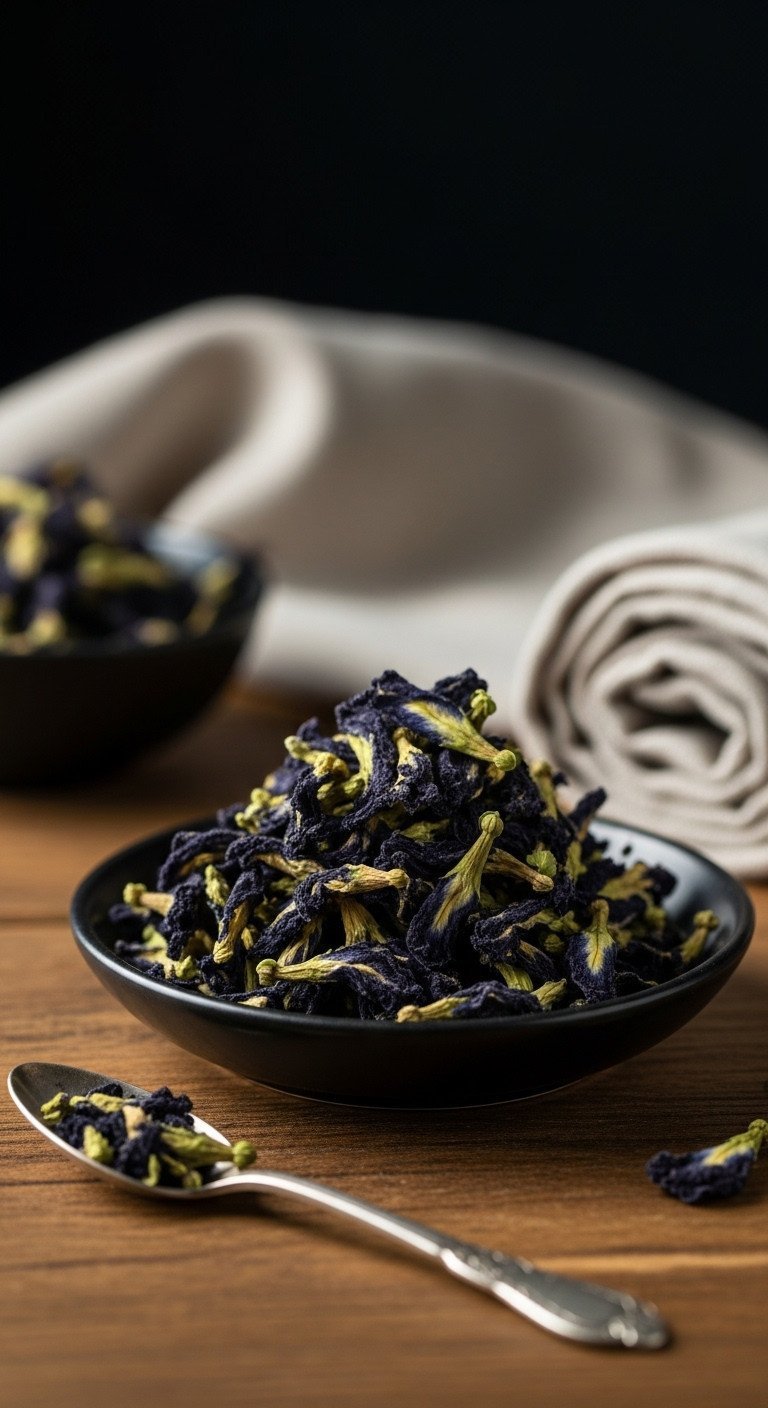
Pin this genius tips to your ‘DIY Drinks’ board!
The foundation of your drink is the Butterfly Pea Flower. For the most potent color, look for high-quality, whole dried flowers online or at Asian markets. Powdered versions can work but often result in a cloudier tea base. The key is concentration; you need enough flowers to create a base that won’t look washed out after adding milk and ice.
Materials Needed:
- High-Quality Dried Butterfly Pea Flowers (whole, not powder)
- Filtered Water (critical for optimal color extraction and pH neutrality)
- Fine-mesh strainer or large tea infuser
Step-by-Step Directions:
- Measure: Use a concentrated ratio of 10-12 flowers per 1 cup (240ml) of water for an intensely pigmented base.
- Boil and Steep: Bring filtered water to a boil, then immediately turn off the heat. Pour over the flowers and steep for exactly 5-7 minutes.
- Strain Quickly: Use the fine-mesh strainer to remove all flower solids quickly to prevent over-extraction of tannins, which can cause a grassy or bitter taste.
- Dispose of Solids: The spent flowers should be immediately discarded or composted.
Pro-Tip: Always use filtered or distilled water. Hard, alkaline tap water can contain minerals that prematurely dull the anthocyanin pigments, resulting in a less vibrant, grayish blue.
2. Mastering the Chewy Boba: The Three-Step Process for ‘Q’ Texture

Save this clever organization idea!
The perfect boba has a specific bouncy, chewy consistency known as ‘Q’ texture. Achieving this at home is easy if you follow a precise three-step process. The biggest mistakes are under-rinsing the cooked tapioca pearls, which leaves them sticky and clumpy, or letting them cool without a syrup bath, which makes them rock-hard.
Materials Needed:
- Raw Tapioca Pearls (quick-cooking or standard)
- Water (7 parts water to 1 part pearls ratio)
- Brown Sugar (for the soaking syrup)
- Vanilla Extract (optional flavor boost)
Step-by-Step Directions:
- Boil and Cook: Bring the water to a rolling boil. Add the pearls and stir immediately to prevent sticking. Cook according to package directions, typically 15-30 minutes, ensuring they are translucent. Turn off heat, cover, and let rest for 15 minutes.
- Rinse Aggressively: Drain the boba and immediately transfer them to a bowl of cold water. Rinse thoroughly under running cold water, stirring constantly until all excess starch is removed and the pearls are no longer sticky or slimy.
- Syrup Soak: Prepare a brown sugar simple syrup (1 part water, 1 part brown sugar). Transfer the rinsed pearls directly into the warm syrup. Let them soak for at least 15-20 minutes to sweeten and prevent hardening.
Lesson Learned: Cooked boba should never be stored in the refrigerator. It rapidly hardens into an unusable texture. It must be prepared fresh and consumed within 4-6 hours while soaked in syrup at room temperature.
3. Rapid Chilling for Zero Dilution
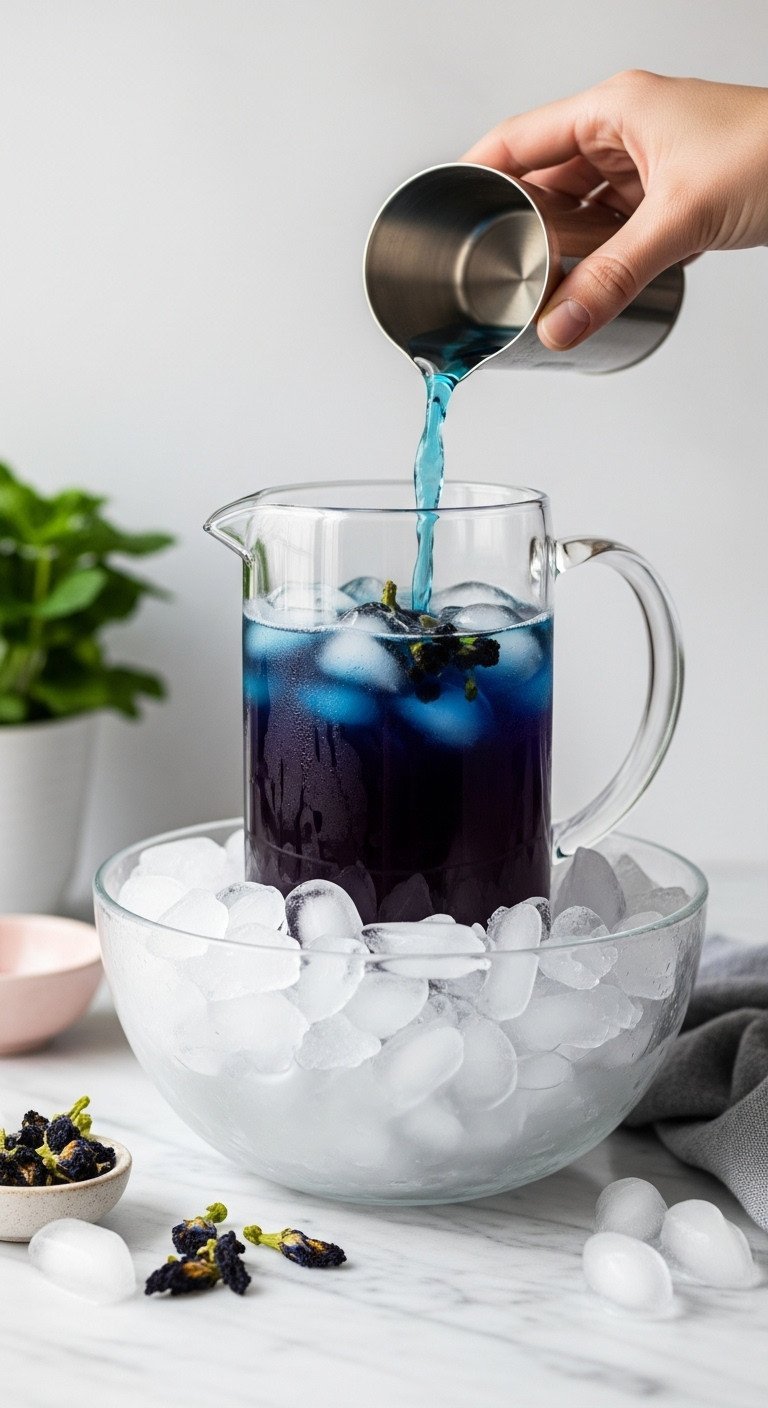
Grab this essential tea accessory!
Pouring hot tea over ice is the fastest way to get a watery, diluted drink. To maintain maximum flavor and color concentration, use a professional technique called an ice bath. This rapidly drops the tea’s temperature without adding a single drop of extra water, preserving the vibrant blue anthocyanin pigments which are sensitive to prolonged heat.
Materials Needed:
- Freshly Steeped Butterfly Pea Tea Base (from H3 1)
- Large mixing bowl
- Plenty of Ice Cubes or Crushed Ice
Step-by-Step Directions:
- Prepare Bath: Fill the large mixing bowl halfway with ice cubes and cold water.
- Submerge: Place the container holding the hot, strained tea base directly into the ice bath, ensuring the water level in the bath is higher than the tea level in the inner container.
- Agitate: Gently stir the tea base for 5-10 minutes, ensuring uniform cooling. This rapidly drops the temperature.
- Target Temperature: Chill until the tea base is cold (below 40°F), then remove it from the ice bath.
Pro-Tip: Pre-cooling the tea is crucial. If hot tea hits ice, the ice melts rapidly, resulting in a thin, watery drink base and a duller final color.
4. Crafting the Optimal Sweetener: Simple Syrup vs. Condensed Milk
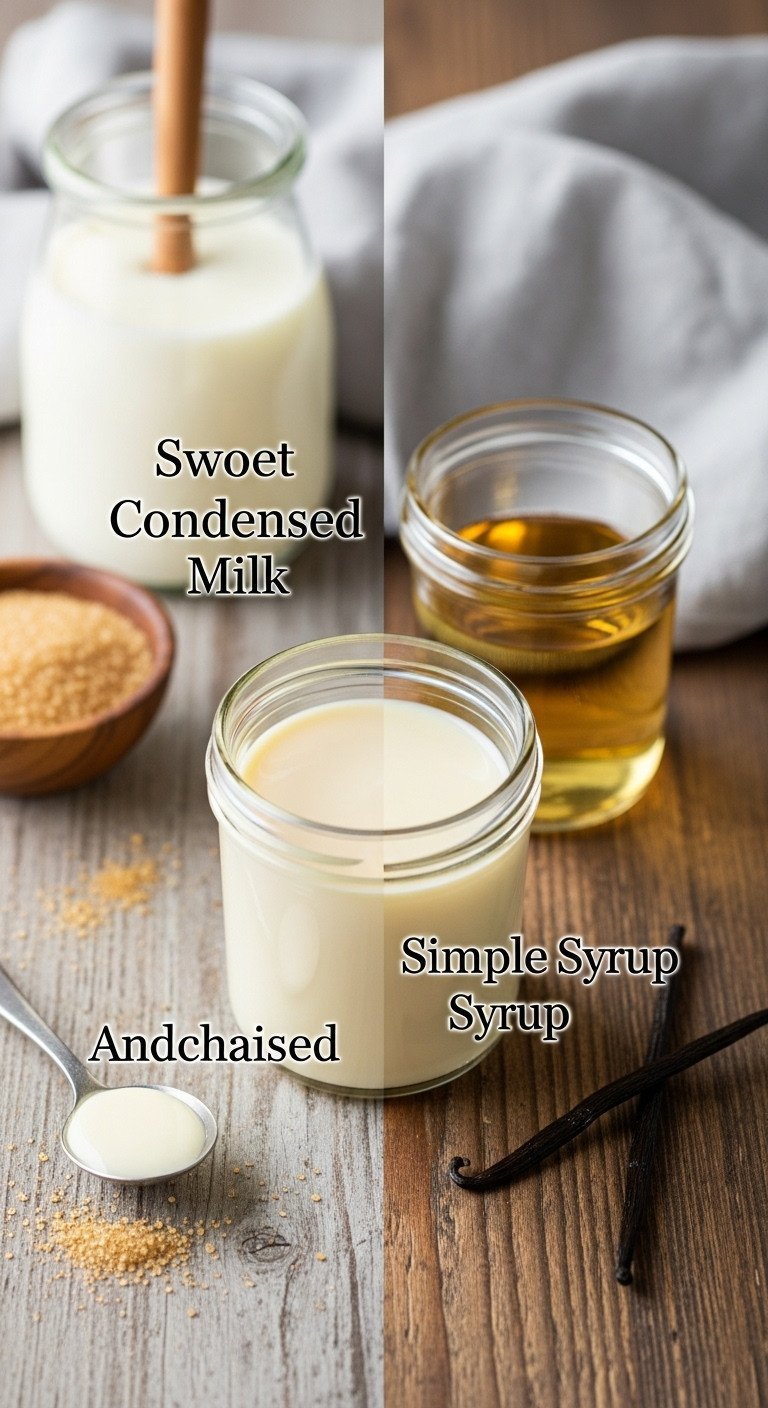
Pin this flavor secret to your ‘Bubble Tea Recipes’ board!
Your choice of sweetener dramatically impacts the final flavor and texture. For a rich, creamy, Thai-inspired drink, sweetened condensed milk is the classic choice. For a lighter, vegan-friendly option that lets the floral notes shine through, a simple syrup is best.
Materials Needed:
- Choice A: Sweetened Condensed Milk (or vegan alternative)
- Choice B: Simple Syrup (1:1 ratio cane sugar to water, simmered)
- Optional: Vanilla extract or a dash of evaporated milk (for Thai-style richness)
Step-by-Step Directions:
- Select Base: If choosing a Thai-inspired creamy base, mix 1 part condensed milk with 1 part evaporated or fresh milk.
- Vegan Base: If choosing a vegan base, combine oat milk (best creaminess) with 2-3 tablespoons of simple syrup per serving.
- Initial Sweetening: Add the chosen sweetener directly to the cooled tea base and stir thoroughly before adding any ice or additional fresh milk. This prevents the sweetener from sinking to the bottom.
- Taste Test: Always taste the sweetened tea base before final assembly; the milk component will reduce the perception of sweetness slightly.
Pro-Tip: Condensed milk adds both sweetness and richness that plain milk lacks. For a lighter drink, use fresh milk mixed with a simple syrup ratio of 1.5 parts sugar to 1 part water for optimal cold dissolution.
5. Unlocking the Color Change Secret: pH Science with Citrus
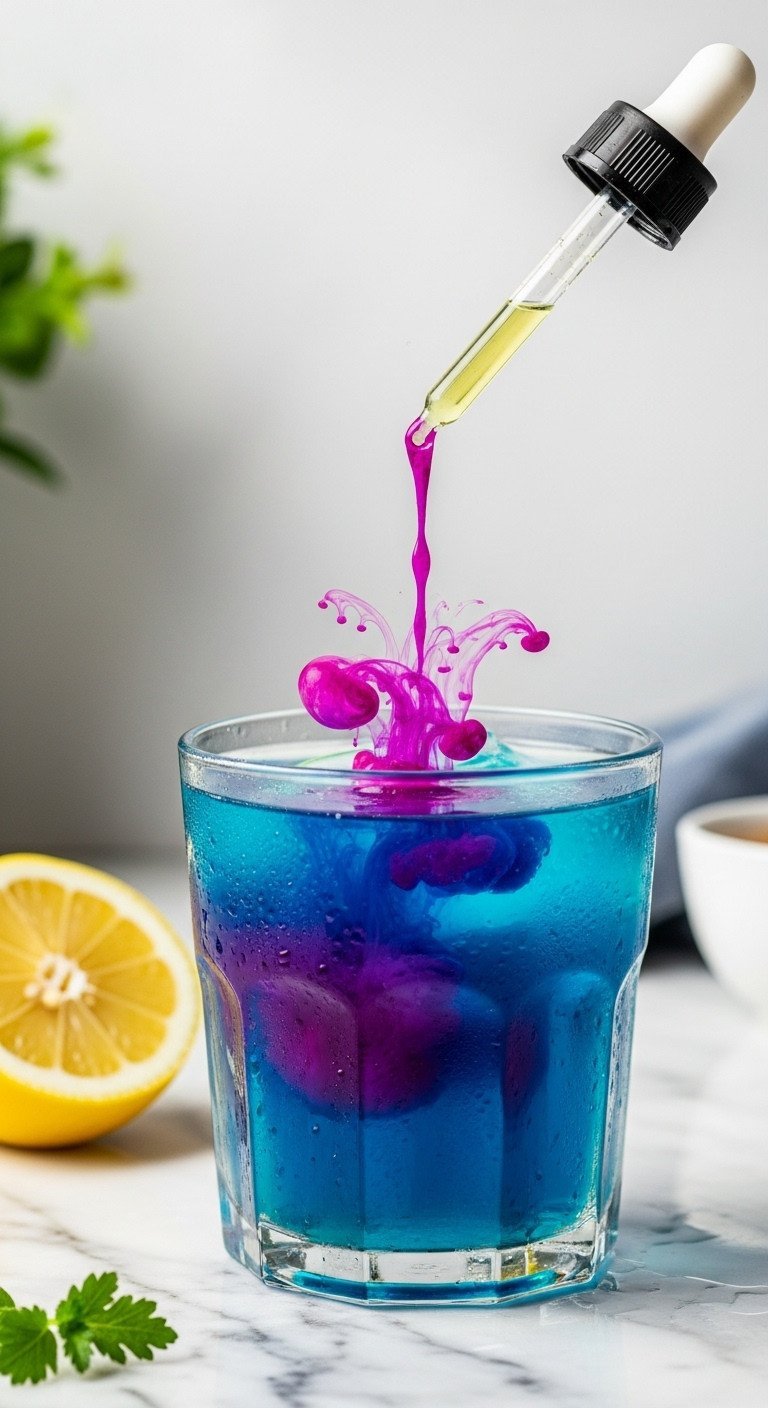
Save this unique pH indicator science trick!
Here’s the magic. The anthocyanin pigments in butterfly pea flowers are natural pH indicators. This means they change color when they come into contact with an acid. By adding a little bit of lemon or lime juice, you can transform your blue milk tea into a vibrant purple or magenta masterpiece.
Materials Needed:
- Cooled Blue Milk Tea Base (fully mixed with sweetener)
- Fresh Lemon or Lime Juice (key acidic component)
- Small measuring spoon or dropper
Step-by-Step Directions:
- Prepare Acid: Squeeze fresh lemon or lime juice (fresh tastes better than bottled).
- Test: Add a few drops of citrus juice to a small sample of the tea base. Observe the immediate reaction: the blue pigment will shift to purple or pink.
- Integrate: If you desire a purple milk tea, stir 1/2 to 1 teaspoon of citrus juice into the main tea base before adding the fresh milk layer. Note that adding acid will negate the layering effect, as the milk layer will turn purple as well.
- Flavor Balance: Remember that adding citrus juice brightens the flavor but also adds tartness, which must be balanced by additional sweetener if needed.
Expert Insight: The pH level in the blue tea is around pH 7-8 (neutral/slightly alkaline). Adding lemon juice drops the pH to around pH 4.5 or lower, which causes the anthocyanin molecule to change its chemical structure, resulting in the vibrant purple or magenta color.
6. The Art of Layering: Creating the Gradient Effect
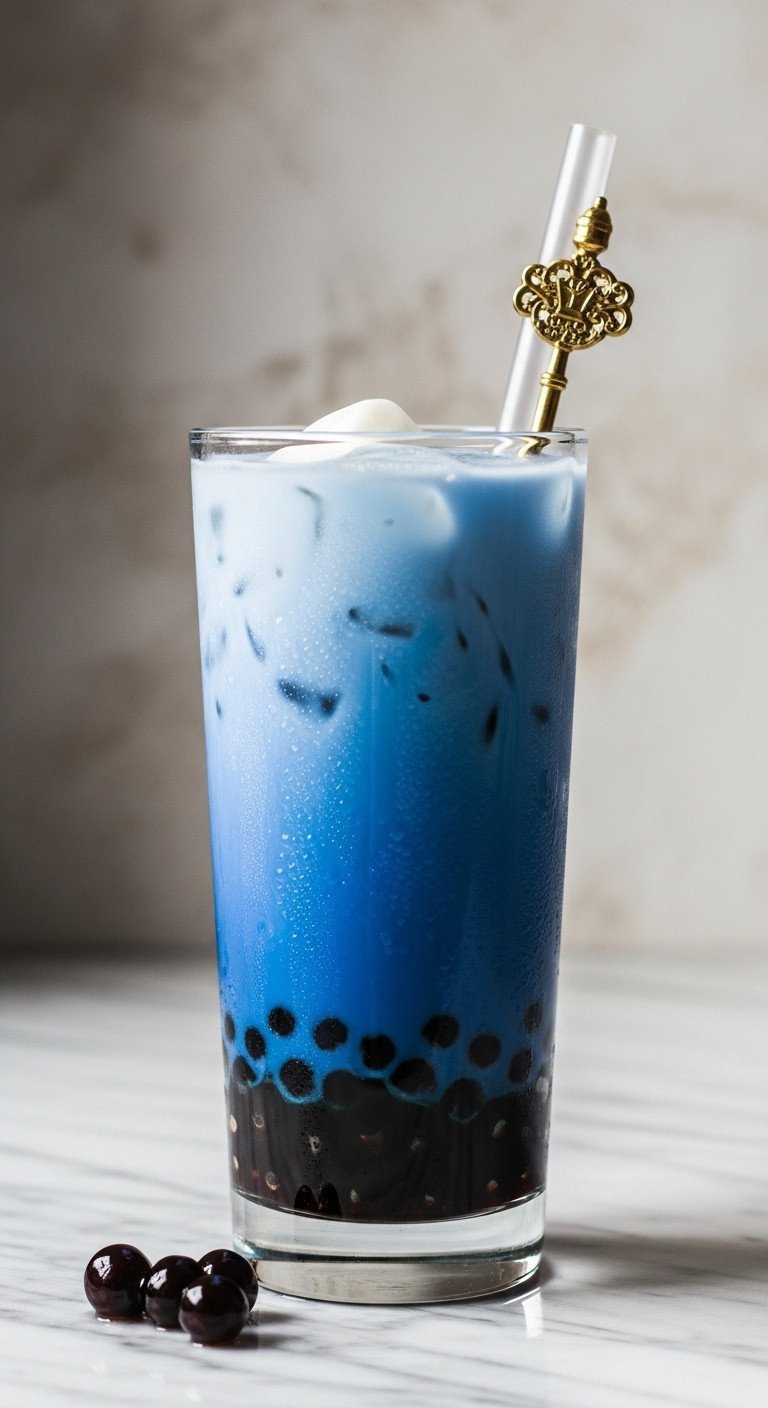
Save this aesthetic layering technique!
The secret to that beautiful Instagrammable gradient effect is all about density and a slow, careful pour. The sugary tea base is denser than the fresh milk. By using ice as a barrier and pouring the milk slowly, you can make it float on top, creating distinct layers.
Materials Needed:
- Cooled, Sweetened Tea Base
- Cooked Boba (in syrup, if using)
- Fresh Milk (dairy or non-dairy, full-fat recommended)
- Tall, Clear Glass and plenty of ice
Step-by-Step Directions:
- Boba First: Scoop the warm boba pearls and a spoonful of their syrup into the bottom of the glass.
- Ice Layer: Fill the glass completely with ice cubes. This acts as a barrier to keep the liquids from mixing too quickly.
- Tea Pour: Gently pour the cooled, sweetened blue tea base over the ice until the glass is about 3/4 full.
- The Slow Pour: Hold a spoon or small ladle upside down, resting the tip just above the ice level. Slowly pour the fresh milk over the back of the spoon. The reduced velocity prevents immediate mixing, allowing the milk to float on top.
Pro-Tip: For the most dramatic layering, use a denser base (more sweetener) and a milk with a slightly lower density (like low-fat dairy or a lighter plant milk).
7. Vegan and Dairy Milk Optimization: Creaminess vs. Color

Pin this definitive comparison guide now!
Choosing the right milk is a balancing act between creaminess and color vibrancy. High-fat dairy offers the richest texture but can slightly mute the blue. For vegan blue milk tea, different plant-based milks have very different results.
Materials Needed:
- Dairy Whole Milk (High Creaminess, Rich Flavor)
- Oat Milk (Highest Creaminess among vegan options, best color retention)
- Almond Milk (Lowest Creaminess, least impact on color)
- Coconut Milk (Added tropical flavor, high fat)
Step-by-Step Directions:
- Test Saturation: Prepare the highly concentrated tea base. Mix a small sample with equal parts of your chosen milk. Observe how much the milk’s opaqueness mutes the blue color.
- Assess Creaminess: Taste test for texture. Oat milk provides the best mouthfeel substitute for dairy.
- Coconut Flavor: If using coconut milk, ensure the added coconut flavor complements your chosen sweetener.
- Adjust Sweetness: If you swap condensed milk for plain fresh milk, you must compensate by adding 1.5-2x the amount of simple syrup to maintain the desired sweetness level.
Expert Insight: Oat milk offers the ideal blend of richness (similar mouthfeel to dairy) and neutral flavor, making it the most recommended vegan base for Blue Milk Tea. Its slight natural sweetness also requires less added syrup.
8. The Warm Variation: Spiced Blue Moon Milk
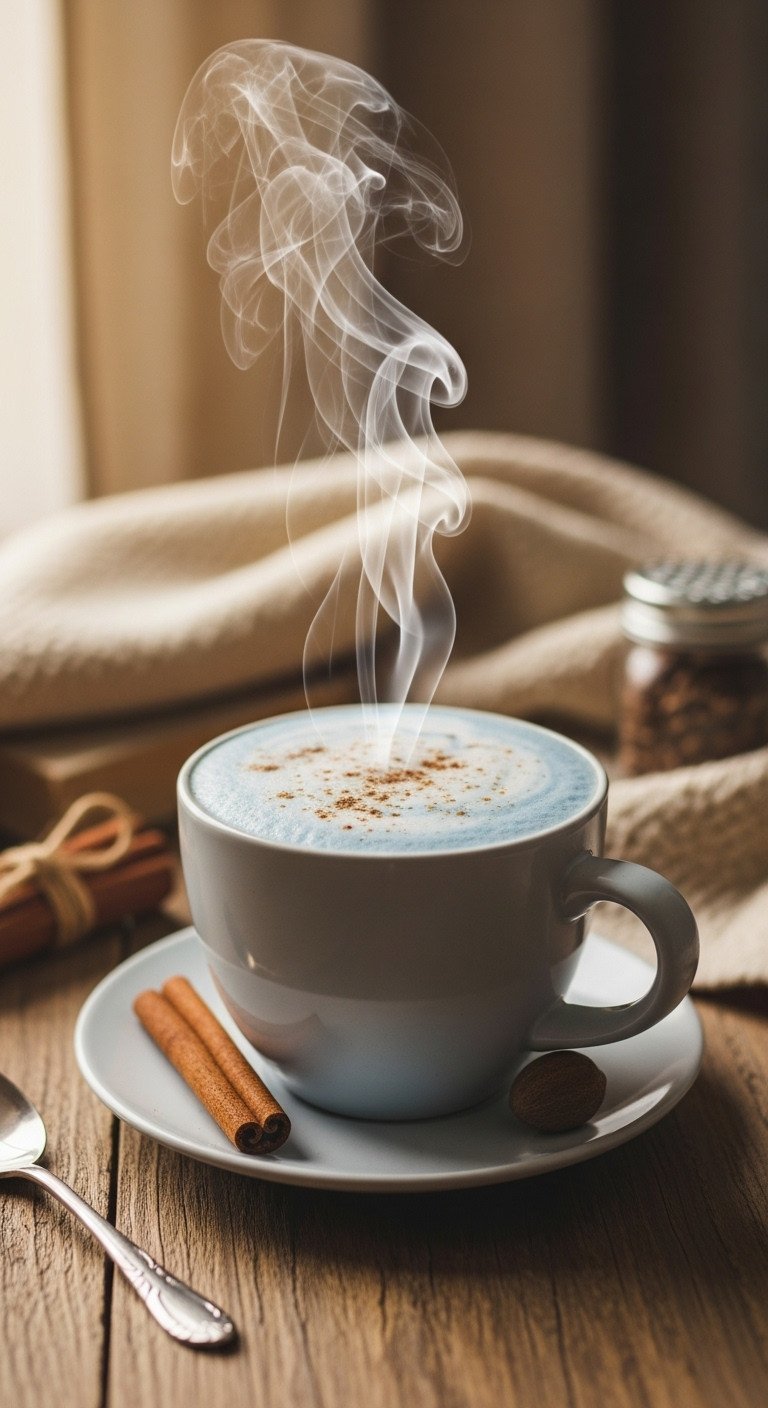
Pin this relaxing nighttime remedy!
The butterfly pea base isn’t just for iced drinks. It’s the perfect foundation for a warm, calming “Blue Moon Milk,” a caffeine-free nightcap often infused with warming spices and wellness-focused adaptogens like ashwagandha.
Materials Needed:
- Butterfly Pea Flowers (standard ratio)
- Milk (dairy or creamy non-dairy)
- Sweetener (honey or maple syrup)
- Warming Spices (cardamom, cinnamon sticks, ginger powder, nutmeg)
- Optional: Ashwagandha powder (adaptogen)
Step-by-Step Directions:
- Steep Spices: In a small saucepan, gently warm the milk and stir in the spices, honey/syrup, and optional adaptogen powder. Heat until just simmering (do not boil).
- Infuse Tea: While the milk is warming, steep the butterfly pea flowers (5 flowers per cup) in a small amount of hot water (1/4 cup) for 5 minutes. Strain the highly concentrated blue tea.
- Combine: Pour the strained blue tea concentrate into the spiced, warm milk. The mixture will immediately turn a soothing, soft blue-lavender color.
- Serve: Pour into a mug, garnish with a dusting of cinnamon, and serve immediately for a relaxing nightcap.
Lesson Learned: Use the spice blend sparingly. The delicate floral notes of the Butterfly Pea Flower can be easily overwhelmed by robust spices like cinnamon or turmeric.
9. Flavor Customization: Vanilla, Pandan, and Floral Enhancements
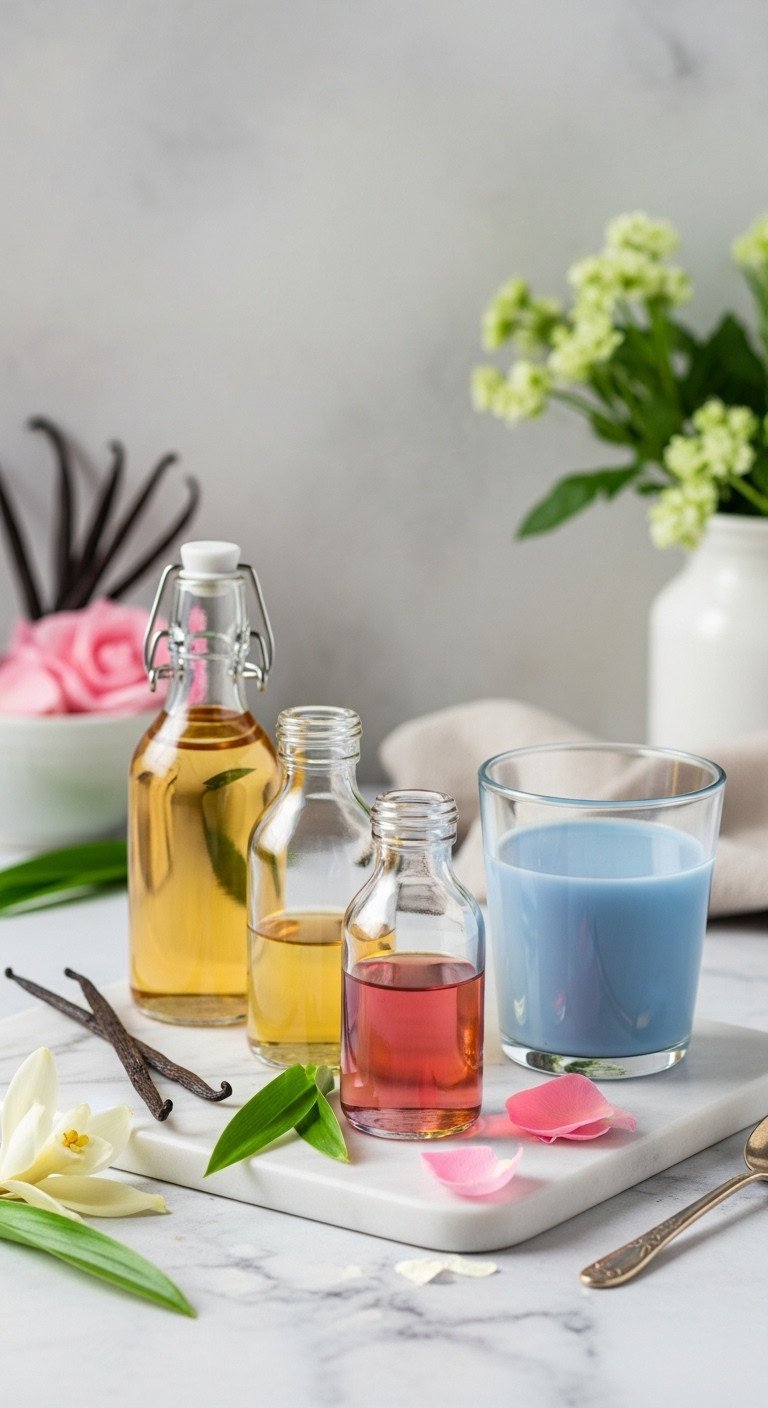
Pin this customization chart to your ‘Mixology Ideas’!
The subtle, earthy flavor of butterfly pea tea is a perfect canvas for customization. Adding simple flavorings like vanilla, pandan, or even floral syrups can elevate your drink from a simple recipe to a complex, signature beverage.
Materials Needed:
- Flavoring Agent: Vanilla Bean (scraped) or Quality Vanilla Extract
- Pandan Extract or Fresh Leaves (for subtle Southeast Asian complexity)
- Other Syrups: Rosewater or Lavender Syrup
Step-by-Step Directions:
- Vanilla Boost: Add vanilla extract or a scraped vanilla bean to your simple syrup recipe while simmering for a classic, sweet complexity that mitigates the earthy notes.
- Pandan Infusion: If using pandan, steep a small torn leaf alongside the butterfly pea flowers for the final 2 minutes of steeping. Pandan adds a subtle, nutty, floral fragrance common in Thai desserts.
- Rose/Lavender: For a distinctly European floral note, replace half of your simple syrup volume with a pre-made rose or lavender syrup when sweetening the tea base.
- Test Ratios: Always add flavorings conservatively (start with 1/2 teaspoon per serving) and adjust, as floral flavors can quickly become overpowering.
Pro-Tip: If using jasmine tea instead of water to steep the butterfly pea flowers, brew the jasmine tea first (separately, 3 minutes max) and then use that hot liquid to steep the butterfly pea flowers for the final 5 minutes.
Key Takeaways: Your Quick Guide to Blue Milk Tea Success
To guarantee success, focus on these five critical factors. They are the difference between a good attempt and a perfect, professional-quality blue milk tea.
- Color Lock: Use filtered water and the Rapid Chill Method immediately after steeping to preserve the vibrant blue hue by protecting the delicate anthocyanin pigments.
- Boba Texture: The two most critical steps are aggressive rinsing of the cooked tapioca pearls to remove excess starch, and soaking them immediately in warm brown sugar syrup.
- Creaminess Choice: For a non-dairy option, oat milk is the best substitute for dairy or condensed milk, providing maximum creaminess with minimal compromise to the blue color.
- Flavor Base: Use a concentrated ratio of 10-12 butterfly pea flowers per cup of water to create a strong tea base that stands up to the sweetness and milk.
- Aesthetic Layering: Pour the fresh milk very slowly over the back of a spoon that is resting on the ice layer to achieve a distinct, professional color gradient.
People Also Ask About Blue Milk Tea
What exactly does blue milk tea taste like?
Blue Milk Tea has a mild, subtly earthy, and floral flavor profile, which is naturally delicate. The taste is often compared to a light herbal infusion. However, the final flavor is highly dependent on the amount and type of sweetener used (like condensed milk, simple syrup, or vanilla), which transforms the earthy tea base into a creamy, sweet, and complex latte.
Is the blue color safe to drink, and are there any health benefits?
Yes, the blue color is completely safe as it comes from the natural anthocyanin pigments found in the Butterfly Pea Flower (Clitoria ternatea). No artificial dyes are needed. The flower is traditionally used in Southeast Asia and is rich in antioxidants, leading to claims of mild cognitive and wellness benefits, although the overall health profile depends on the sugar content added to the milk tea.
How long can I store homemade blue milk tea and boba?
The strained, cooled blue tea base can be stored in an airtight container in the refrigerator for up to 5 days. However, once mixed with milk, it should be consumed within 24 hours. The prepared boba is the most perishable component; for optimal texture (“Q” chewiness), it must be consumed within 4–6 hours of cooking and should never be refrigerated.
Why did my blue milk tea turn a grayish color instead of vibrant blue?
A dull or grayish color is usually caused by an alkaline pH imbalance, often due to hard tap water or insufficient steeping concentration. To fix this, always use filtered or distilled water when steeping the flowers. If the color is still dull, increase the concentration of the flowers (use 12+ flowers per cup) to ensure maximum pigment extraction.
Can I make blue milk tea without boba?
Absolutely. Blue Milk Tea is delicious even without the chewy tapioca pearls. When omitting boba, the drink becomes a beautiful, creamy specialty tea latte. The texture focus shifts to the richness of the milk, so consider using a higher fat milk (whole dairy or barista blend oat milk) to maintain a luxurious mouthfeel.
Final Thoughts
With the secrets of pH science, ingredient ratios, and boba mastery in hand, you are now equipped to create Blue Milk Tea that surpasses any store-bought version. The Clitoria ternatea flower offers both stunning aesthetics and a delicate flavor profile, making it the perfect canvas for your culinary experimentation. Don’t be afraid to try different milks and sweeteners until you find your perfect balance.
What is your favorite flavor pairing with the subtle floral notes of Butterfly Pea Tea—are you a vanilla purist, or do you prefer the warm spice of Blue Moon Milk? Let us know your signature recipe in the comments below
Last update on 2025-12-05 / Affiliate links / Images from Amazon Product Advertising API

